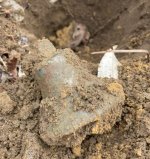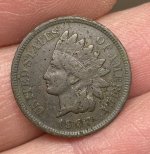lenmac65
Silver Member
- Jul 28, 2009
- 2,766
- 8,857
- 🥇 Banner finds
- 3
- Detector(s) used
- Garrett AT Pro, Equinox 800 (as of 10/2019)
- Primary Interest:
- Metal Detecting
I dug this open mouth bell in the woods today in an area that used to be farmland. It rang up like a can on first pass, but I was nonetheless hopeful, as it made no noise when I lifted my coil 6 to 12 inches up. I have seen these called Conestoga wagon bells. I included an antique picture circa 1910 that shows the bells as attached. I am not sure of the age of mine, though I am guessing late 1800s or early 1900s. (I have seen similar ones posted claiming to be late 1700s or early 1800s, so who knows.) It has no markings and the clapper is gone. I also found a 1907 Indian Head penny near this same area last week. It cleaned up nice with peroxide, but I think I left it in too long, as it is now pitted 😞. Happy hunting!






Amazon Forum Fav 👍
Last edited:
Upvote
44






